-
Countries
-
Data and Analysis
-
Special Focus
-
Crisis Responses
Dashboard/Fact Sheet
Color
-

Contact
dtmuganda@iom.int
Language
English
Location
Uganda
Period Covered
Feb 19 2024
Mar 19 2024
Activity
- Flow Monitoring
Over the reporting period, a total of 15,885 movements were observed at five Flow Monitoring Points (FMPs) through random interviews with travelers. These locations were chosen strategically as major transit points for monitoring movements in and out of Nakivale refugee settlement and from the border between Uganda and the Democratic Republic of Congo through Nyakabande Transit Center. In the reporting period (19 February, 2024 - 19 March, 2024) the majority of movements from Nakivale settlement were outgoing flows at 59% against incoming flows (at 41%). Forty-four per cent of the observed movements were refugees at the five FMPs.
The means of transport commonly used was foot at 37%). Other means used included; motor bike & bike (28%), taxi or car (23%), truck (8%), bus (2%) and others (2%). Most of the flows were due to economic reasons at 29%). Other reasons for the movements included; family reasons (15%) and return (14%). Most of the movements were observed at the Nakivale check point FMP representing 52%) followed by Busanza at 18%), Bunagana (17%), Rugaaga (8%) and Nyakabande transit centre (5%).
Vulnerabilities among the travelers was mostly registered among children under five at 6%), pregnant and/lactating mother at 6%) and the elderly (at 1%).
Out of the 4,531 movements driven by economic reasons, 60% were business related activities such as one-off market transactions, sales/purchases, meetings, and business trips. 29% of the movements were regular daily or weekly travel for work or livelihood activities (including commuting and mining). Additionally, 10% of the movements were motivated by job opportunities, while the remaining 1% fell into other categories.
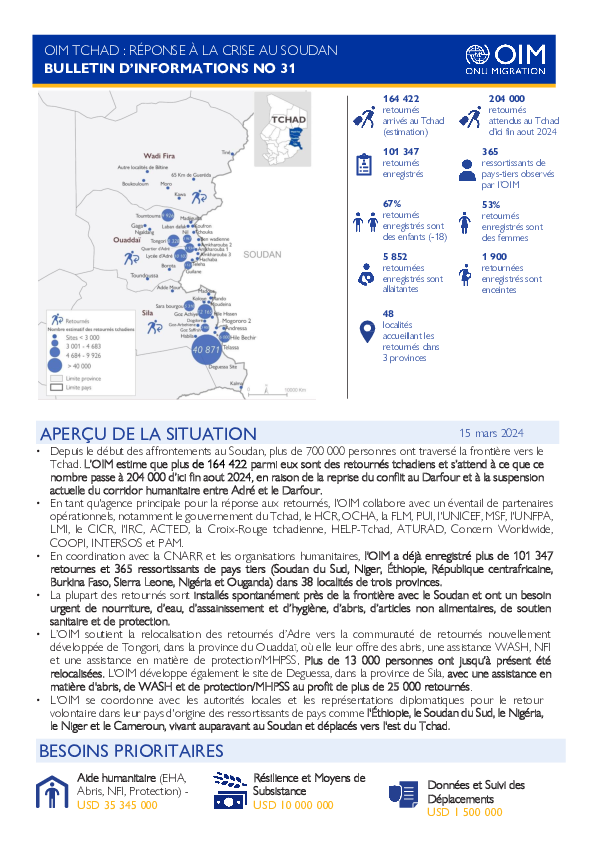
Contact
DTM Chad, dtmtchad@iom.int
Language
French
Location
Chad
Period Covered
Feb 24 2024
Mar 10 2024
Activity
- Mobility Tracking
- Event Tracking
• Depuis le début des affrontements au Soudan, plus de 700 000 personnes ont traversé la frontière vers le Tchad. L’OIM estime que plus de 164 422 parmi eux sont des retournés tchadiens et s’attend à ce que ce nombre passe à 204 000 d’ici fin aout 2024, en raison de la reprise du conflit au Darfour et à la suspension actuelle du corridor humanitaire entre Adré et le Darfour.
• En tant qu'agence principale pour la réponse aux retournés, l'OIM collabore avec un éventail de partenaires opérationnels, notamment le gouvernement du Tchad, le HCR, OCHA, la FLM, PUI, l'UNICEF, MSF, l'UNFPA, LMI, le CICR, l'IRC, ACTED, la Croix-Rouge tchadienne, HELP-Tchad, ATURAD, Concern Worldwide, COOPI, INTERSOS et PAM.
• En coordination avec la CNARR et les organisations humanitaires, l'OIM a déjà enregistré plus de 101 347 retournes et 365 ressortissants de pays tiers (Soudan du Sud, Niger, Éthiopie, République centrafricaine, Burkina Faso, Sierra Leone, Nigéria et Ouganda) dans 38 localités de trois provinces.
• La plupart des retournés sont installés spontanément près de la frontière avec le Soudan et ont un besoin urgent de nourriture, d’eau, d’assainissement et d’hygiène, d’abris, d’articles non alimentaires, de soutien sanitaire et de protection.
• L’OIM soutient la relocalisation des retournés d’Adre vers la communauté de retournés nouvellement développée de Tongori, dans la province du Ouaddaï, où elle leur offre des abris, une assistance WASH, NFI et une assistance en matière de protection/MHPSS. Plus de 13 000 personnes ont jusqu’à présent été relocalisées. L'OIM développe également le site de Deguessa, dans la province de Sila, avec une assistance en matière d'abris, de WASH et de protection/MHPSS au profit de plus de 25 000 retournés.
• L'OIM se coordonne avec les autorités locales et les représentations diplomatiques pour le retour volontaire dans leur pays d'origine des ressortissants de pays comme l'Éthiopie, le Soudan du Sud, le Nigéria, le Niger et le Cameroun, vivant auparavant au Soudan et déplacés vers l'est du Tchad.
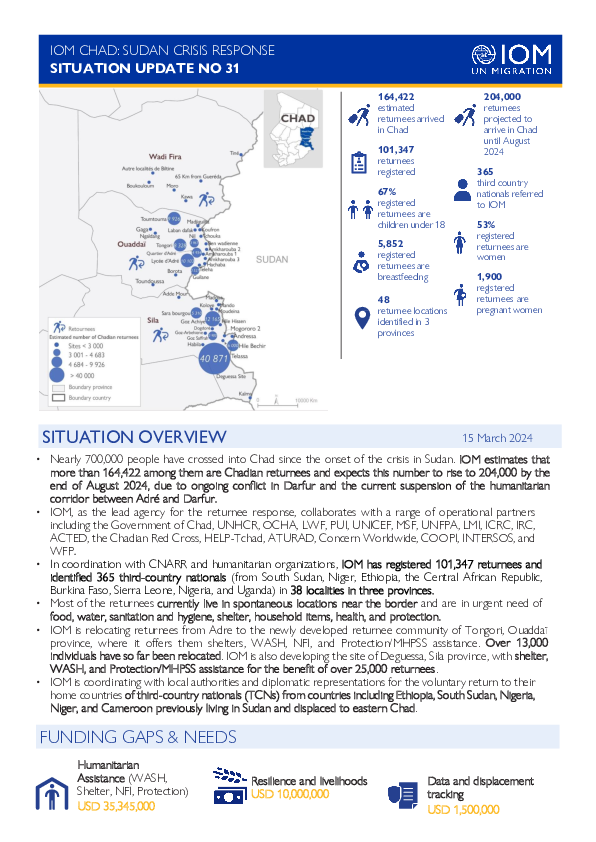
Contact
DTM Chad, dtmtchad@iom.int
Language
English
Location
Chad
Period Covered
Feb 25 2024
May 13 2024
Activity
- Mobility Tracking
- Event Tracking
• Nearly 700,000 people have crossed into Chad since the onset of the crisis in Sudan. IOM estimates that more than 164,422 among them are Chadian returnees and expects this number to rise to 204,000 by the end of August 2024, due to ongoing conflict in Darfur and the current suspension of the humanitarian corridor between Adré and Darfur.
• IOM, as the lead agency for the returnee response, collaborates with a range of operational partners including the Government of Chad, UNHCR, OCHA, LWF, PUI, UNICEF, MSF, UNFPA, LMI, ICRC, IRC, ACTED, the Chadian Red Cross, HELP-Tchad, ATURAD, Concern Worldwide, COOPI, INTERSOS, and WFP.
• In coordination with CNARR and humanitarian organizations, IOM has registered 101,347 returnees and identified 365 third-country nationals (from South Sudan, Niger, Ethiopia, the Central African Republic, Burkina Faso, Sierra Leone, Nigeria, and Uganda) in 38 localities in three provinces.
• Most of the returnees currently live in spontaneous locations near the border and are in urgent need of food, water, sanitation and hygiene, shelter, household items, health, and protection.
• IOM is relocating returnees from Adre to the newly developed returnee community of Tongori, Ouaddaï province, where it offers them shelters, WASH, NFI, and Protection/MHPSS assistance. Over 13,000 individuals have so far been relocated. IOM is also developing the site of Deguessa, Sila province, with shelter, WASH, and Protection/MHPSS assistance for the benefit of over 25,000 returnees.
• IOM is coordinating with local authorities and diplomatic representations for the voluntary return to their home countries of third-country nationals (TCNs) from countries including Ethiopia, South Sudan, Nigeria, Niger, and Cameroon previously living in Sudan and displaced to eastern Chad.

Contact
DTM Chad, dtmtchad@iom.int
Language
English
Location
Chad
Period Covered
Feb 25 2024
Mar 24 2024
Activity
- Mobility Tracking
- Event Tracking
•Nearly 700,000 people have crossed into Chad since the onset of the crisis in Sudan. IOM estimates that more than 164,422 among them are Chadian returnees and expects this number to rise to 204,000 by the end of August 2024, due to ongoing conflict in Darfur and the current suspension of the humanitarian corridor between Adré and Darfur.
• IOM, as the lead agency for the returnee response, collaborates with a range of operational partners including the Government of Chad, UNHCR, OCHA, LWF, PUI, UNICEF, MSF, UNFPA, LMI, ICRC, IRC, ACTED, the Chadian Red Cross, HELP-Tchad, ATURAD, Concern Worldwide, COOPI, INTERSOS, and WFP.
• In coordination with CNARR and humanitarian organizations, IOM has registered 110,958 returnees and identified 365 third-country nationals (from South Sudan, Niger, Ethiopia, the Central African Republic, Burkina Faso, Sierra Leone, Nigeria, and Uganda) in 38 localities in three provinces.
• Most of the returnees currently live in spontaneous locations near the border and are in urgent need of food, water, sanitation and hygiene, shelter, household items, health, and protection.
• IOM is relocating returnees from Adre to the newly developed returnee community of Tongori, Ouaddaï province, where it offers them shelters, WASH, NFI, and Protection/MHPSS assistance. Over 13,000 individuals have so far been relocated. IOM is also developing the site of Deguessa, Sila province, with shelter, WASH, and Protection/MHPSS assistance for the benefit of over 25,000 returnees.
• IOM is coordinating with local authorities and diplomatic representations for the voluntary return to their home countries of third-country nationals (TCNs) from countries including Ethiopia, South Sudan, Nigeria, Niger, and Cameroon previously living in Sudan and displaced to eastern Chad.
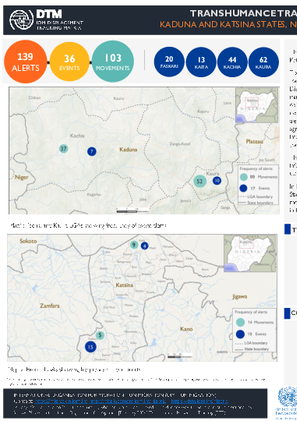
Contact
DTM Nigeria, iomnigeriadtm@iom.int
Language
English
Location
Nigeria
Period Covered
Feb 01 2024
Feb 29 2024
Activity
- Other
In February 2024, the TTT early warning tool captured 139 alerts in Faskari and Kaita LGAs of Katsina State, and Kachia and Kaura LGAs of Kaduna State. The triangulated alerts included events (26%) and massive/sudden movements (74%) during the period.
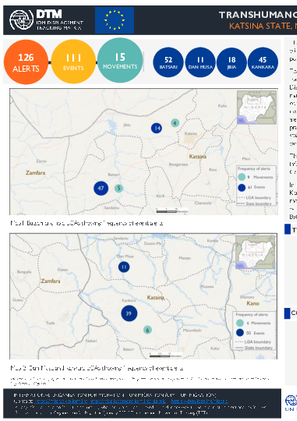
Contact
DTM Nigeria, iomnigeriadtm@iom.int
Language
English
Location
Nigeria
Period Covered
Feb 01 2024
Feb 29 2024
Activity
- Other
In February 2024, the TTT early warning tool captured 126 alerts in Batsari, Dan Musa, Jibia and Kankara LGAs of Katsina State. The triangulated alerts included events (12%) and massive/sudden movements (88%) during the period.
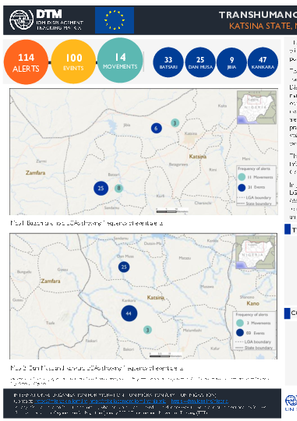
Contact
DTM Nigeria, iomnigeriadtm@iom.int
Language
English
Location
Nigeria
Period Covered
Jan 01 2024
Jan 31 2024
Activity
- Other
In January 2024, the TTT early warning tool captured 114 alerts in Batsari, Dan Musa, Jibia and Kankara LGAs of Katsina State. The triangulated alerts included events (12%) and massive/sudden movements (88%) during the period.

Contact
DTM Nigeria, iomnigeriadtm@iom.int
Language
English
Location
Nigeria
Period Covered
Jan 01 2024
Jan 31 2024
Activity
- Other
In January 2024, the TTT early warning tool captured 150 alerts in Faskari and Kaita LGAs of Katsina State, and Kachia and Kaura LGAs of Kaduna State. The triangulated alerts included events (17%) and massive/sudden movements (83%) during the period.
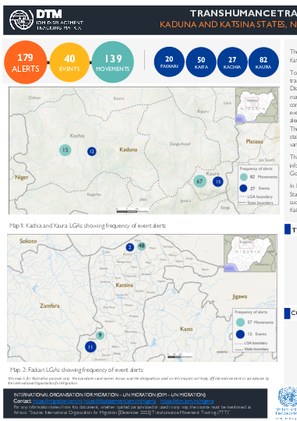
Contact
DTM Nigeria, iomnigeriadtm@iom.int
Language
English
Location
Nigeria
Period Covered
Dec 01 2023
Dec 31 2023
Activity
- Other
In December 2023, the TTT early warning tool captured 179 alerts in Faskari and Kaita LGAs of Katsina State, and Kachia and Kaura LGAs of Kaduna State. The triangulated alerts included events (22%) and massive/sudden movements (78%) during the period.
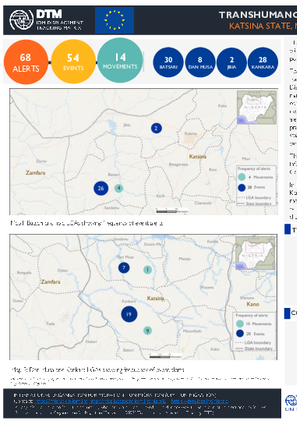
Contact
DTM Nigeria, iomnigeriadtm@iom.int
Language
English
Location
Nigeria
Period Covered
Dec 01 2023
Dec 31 2023
Activity
- Other
In December 2023, the TTT early warning tool captured 68 alerts in Batsari, Dan Musa, Jibia and Kankara LGAs of Katsina State. The triangulated alerts included events (79%) and massive/sudden movements (21%) during the period.
Pagination
- Previous page
- Page 15
- Next page